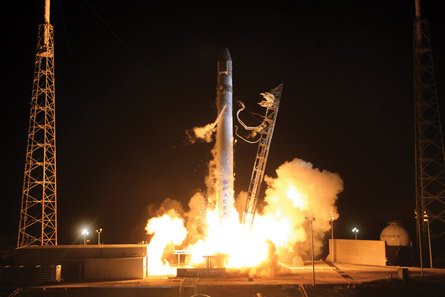Private enterprise boldly went where no private enterprise had gone before on 22 May when SpaceX successfully launched its Falcon 9 rocket and Dragon capsule on a resupply mission to the International Space Station (ISS).
Lifting off from Kennedy Space Center at 03:44 local time, the launch marks the first truly commercial space flight - the first useful flight of a capsule built, launched and operated by a private company.
 |
|---|
SpaceX The mission is a trial run for 12 further flights using the Falcon 9 launcher and Dragon capsule |
This is the start of a long-planned, eagerly awaited transition from government to private-sector resupply of the ISS.
Despite the fact it is considered a test flight by both SpaceX and NASA, it is transporting more than 1,000lb (450kg) of supplies, and will carry a similar load back to Earth. Assuming all goes well, the next flight will be the first of 12 official resupply flights for the company. A similar contract was awarded to Orbital Sciences, which has yet to fly the Antares rocket or Cygnus capsule it will use to fulfil the contract.
MILESTONE MISSION
Speaking at a post-launch press conference, SpaceX founder Elon Musk said: "This mission heralds the dawn of a new era of space exploration - one in which there is a significant commercial space element.
"It is like the advent of the internet in the mid-1990s when commercial companies entered what was originally a government endeavour. That move dramatically accelerated the pace of advancement and made the internet accessible to the mass market," he said. "I think we're at a similar inflection point for space. I hope and I believe that this mission will be historic in marking that turning point towards a rapid advancement in space transportation technology."
This launch was SpaceX's second demonstration flight under a 2006 commercial orbital transportation services (COTS) agreement with NASA to develop the capability to carry cargo to and from the ISS. Although NASA lost a degree of prestige when it retired the Space Shuttle fleet last year, handing the resupply of the ISS to the commercial sector makes financial sense. According to Philip Hylands, space analyst at Ascend, Flightglobal's data and consultancy business, a typical Shuttle mission to resupply the ISS cost at least $300 million, with prices potentially rising as high as $1 billion. A Falcon 9 launch costs just $60 million. Using the Shuttle to haul freight is like "using a helicopter to go to work every day", notes Hylands.
Alongside the resupply missions, SpaceX is also targeting manned spaceflight. After winning awards in the first two rounds, SpaceX is bidding for the third and final round of commercial crew development funding - commercial crew integrated capability (CCiCap) - which could be awarded as early as July.
"I think [the bid was] pretty aggressive on demonstrations," says Gwynne Shotwell, president of SpaceX. "We packed ours full of a lot of hardware, lot of demonstrations, lots of tests I bet we've got more tests in our baseline offer than anybody else."
If NASA can find a commercial partner to perform crew flights to the ISS, then it eases another of its woes, says Hylands: the "embarrassing" need to rely on the Russians and their Soyuz craft to perform the missions.
"Assuming SpaceX can develop this into a regular resupply and crew rotation service, it will help the space station and NASA considerably," says Hylands.
BIG REWARDS
The next step, though, will be to certificate both the Falcon 9 rocket and Dragon capsule for manned spaceflight, a much more complex task. However, although the risks are higher, so too are the rewards - and the kudos, notes Hylands. "Only three nations have ever put men into space: the USA, China and Russia. If a commercial company can manage that, it is up there with those three."
- Additional reporting by Dominic Perry
Source: Flight International


























